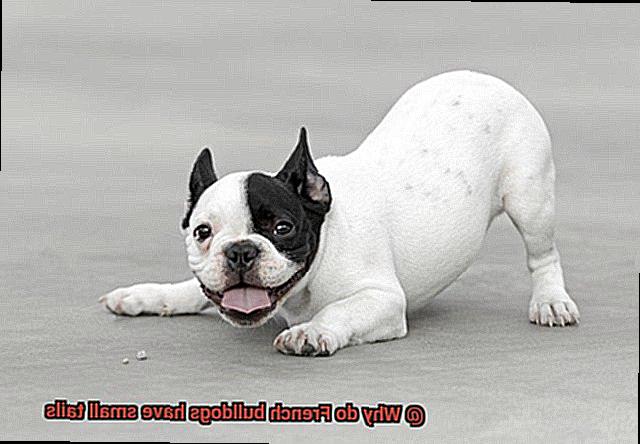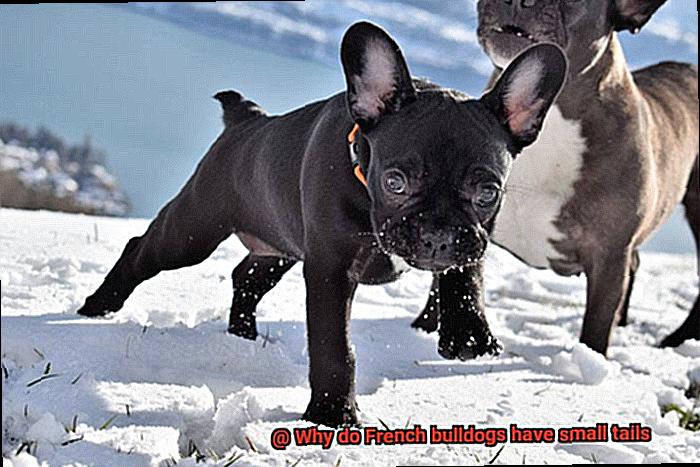Why do French bulldogs have small tails?
French bulldogs, those irresistible bundles of joy and companionship, have stolen the hearts of dog lovers worldwide. With their iconic bat-like ears, sturdy build, and notably diminutive tails, they are instantly recognizable. But have you ever pondered why these lovable canines possess such small tails? In this blog post, we will embark on a captivating journey to unravel the scientific, historical, and cultural reasons behind this endearing trait.
From a scientific perspective, the petite tails of French bulldogs can be attributed to a specific genetic mutation. Alongside other brachycephalic breeds like Boston terriers and English bulldogs, Frenchies are prone to a condition known as screw tail – a twisted and shortened tail. This condition emerged through selective breeding practices that favored individuals with progressively shorter and twisted tails to conform to the desired breed standard.
Historically, French Bulldogs trace their origins back to the late 19th century when English bulldogs were crossed with local French ratters. Originally meant to provide companionship for lace workers fleeing England’s Industrial Revolution, it is believed that breeders selectively bred Frenchie ancestors with shorter and more compact tails for practical reasons – avoiding injuries during ratting and fighting events.
Culturally speaking, French bulldogs have become synonymous with the ideal companion dog due to their affectionate nature. Their unique appearance, including their small tails, has turned them into symbols of elegance, charm, and cuteness. This cultural association has further fueled the demand for French bulldogs with shorter tails, perpetuating ongoing selective breeding practices.
In conclusion, the small tails of French bulldogs arise from a combination of genetic mutations, historical influences, and cultural preferences. While this characteristic may be exclusive to this beloved breed, it carries a vibrant tale of their evolution and enduring allure. In the following sections, we will delve deeper into the genetic and health implications of their short tails, as well as the captivating traits and characteristics that make French bulldogs an irresistible companion for many.
The History of French Bulldogs and Their Small Tails
Contents
- 1 The History of French Bulldogs and Their Small Tails
- 1.1 The Origins: A Tale of Ancestry and Migration
- 1.2 Selective Breeding: The Quest for Compact Perfection
- 1.3 Body Structure: The Anatomy Behind the Tail Size
- 1.4 Health Considerations: Ensuring Comfort and Happiness
- 1.5 Variations Within the Breed: A Tail for Every Frenchie
- 1.6 Caring for Their Tails: Nurturing Their Unique Appendages
- 2 Genetics and Spinal Structure Contribute to French Bulldogs’ Small Tails
- 3 Aesthetics of the French Bulldog’s Small Tail
- 4 Practical Benefits of the French Bulldog’s Small Tail
- 5 Variations in Tail Shape Among Individual Dogs
- 6 Caring for a French Bulldog’s Small Tail
- 7 Conclusion
Let’s dive into the captivating history of these delightful dogs and unravel the reasons behind their unique tails.
The Origins: A Tale of Ancestry and Migration
French Bulldogs trace their roots back to England, where their ancestors, the English Bulldogs, roamed with larger bodies and longer tails. However, during the Industrial Revolution, lace workers from Nottingham migrated to France and brought their beloved Bulldogs with them. In France, breeders selectively bred these Bulldogs to create a smaller version of the breed, setting the stage for the development of French Bulldogs with smaller tails.
Selective Breeding: The Quest for Compact Perfection
French Bulldog breeders in France had a vision – to create a compact and muscular dog with a sturdy build. As part of this meticulous breeding process, they focused on achieving shorter tails. Why? Well, shorter tails were not only considered more aesthetically pleasing but also aligned with the overall compact appearance that these breeders desired.
Body Structure: The Anatomy Behind the Tail Size
French Bulldogs boast a unique body shape characterized by a short spine, broad chest, and large head. This distinctive physique often results in a naturally shorter tail. The shortened spine simply doesn’t provide enough space for a longer tail to be comfortably carried or wagged. It’s as if nature designed them to have petite tails.
Health Considerations: Ensuring Comfort and Happiness
Beyond aesthetics and body structure, there are health considerations associated with French Bulldogs’ small tails. Due to their shortened spines, these lovely pups are prone to spinal abnormalities such as hemivertebrae or screw tail. By selectively breeding for smaller tails, breeders help reduce the risk of these spinal issues, ensuring that our furry friends can lead happy and comfortable lives.
Variations Within the Breed: A Tail for Every Frenchie
While most French Bulldogs have small tails, it’s important to note that not all tails are extremely short or non-existent. Some Frenchies may have slightly longer tails, while others may have naturally short but visible tails. This variation adds to the uniqueness and individuality of each French Bulldog, making them all the more endearing.
Caring for Their Tails: Nurturing Their Unique Appendages
Just like any other body part, French Bulldogs’ tails require care and attention. Regular cleaning and inspection are necessary to ensure there are no infections or irritations. Additionally, providing a comfortable environment and avoiding activities that could potentially strain their tails will help keep these adorable appendages in tip-top shape.
Genetics and Spinal Structure Contribute to French Bulldogs’ Small Tails
Join us on a captivating journey as we delve into the realm of French Bulldog tails, uncovering the role of genetics and spinal structure in shaping this distinctive characteristic.
Genetics: The C189G Mutation:
At the core of this fascinating tale is a genetic mutation known as the C189G mutation. This mutation exerts its influence during the embryonic growth stage, altering the development of the tail and resulting in a shorter length. Breeders, with a keen eye for detail, selectively choose French Bulldogs carrying this genetic trait, ensuring that subsequent generations retain their signature small tails.
Spinal Structure: The Marvel of Hemivertebrae:
French Bulldogs possess a remarkable spinal structure that contributes to their diminutive tails. Hemivertebrae, a condition commonly found in brachycephalic breeds such as French Bulldogs, causes certain vertebrae in their spine to be deformed or misshapen. This abnormality can lead to tails that are shorter than usual or even adopt a distinctive corkscrew-like appearance, adding an extra touch of uniqueness to these lovable canines.
Health Considerations:

While small tails are considered a defining characteristic of French Bulldogs, it is essential to be mindful of potential health issues that may arise. Misaligned vertebrae or spinal abnormalities associated with short tails can cause discomfort and pain for these endearing companions. In severe cases, surgical intervention may be necessary to improve their overall quality of life.
Aesthetics of the French Bulldog’s Small Tail
You must have been captivated by their enchanting small tails that add an extra touch of charm and appeal. In this blog post, let us delve into the aesthetics of these petite tails and explore why they are adored by dog lovers and breeders alike.
The French Bulldog’s small tail, affectionately known as a “screw tail” or a “bunny tail,” is a true testament to their unique beauty. Its shape perfectly complements their overall appearance, enhancing their compact and muscular build. Whether straight or slightly curved, this petite tail sits high on their rear end, creating an elegant silhouette that is simply delightful to behold.
One cannot help but be mesmerized by the expressive nature of these small tails. Despite their size, they wag with vigor when the French Bulldog is overcome with happiness or excitement, adding an extra dose of joy to their already delightful personality. Just imagine the pure happiness of witnessing your furry friend wagging their tiny tail with exuberance.
Beyond their wagging prowess, the small tail lends an air of sophistication and charisma to the breed’s characteristic “swagger” when they strut their stuff. It is a small detail that has a big impact on their overall magnetism and makes them even more irresistible to anyone lucky enough to witness their graceful movements.
As dog enthusiasts and responsible breeders admire the aesthetics of the French Bulldog’s small tail, it is important to note that it does not compromise their health or well-being. However, it is crucial to remain vigilant about potential health considerations associated with misaligned vertebrae or spinal abnormalities. Regular veterinary check-ups are necessary to ensure the continued well-being of these beloved companions.
Practical Benefits of the French Bulldog’s Small Tail

French Bulldogs are adored for their cute appearance, and their small tails undoubtedly contribute to their overall charm. However, beyond their visual appeal, these petite tails offer a range of practical benefits that make them even more endearing. Let’s explore the practical advantages of the French Bulldog’s small tail.
First and foremost, the small tail reduces the risk of injury. French Bulldogs are known for their playful nature, and their tiny tails are less likely to get caught on objects or accidentally stepped on compared to larger tails. This helps prevent painful tail injuries such as fractures or dislocations, ensuring that your furry friend stays happy and healthy.
Another practical benefit is the reduced maintenance that comes with a small tail. French Bulldogs already have a short coat, and having a small tail makes grooming and keeping it clean a breeze. Unlike breeds with longer, bushy tails, there’s no need for extensive brushing or worrying about tangles. This saves precious time and effort for owners who prefer low-maintenance grooming routines.
The small tail also contributes to the overall balance and symmetry of the French Bulldog’s body. It complements their compact and muscular build, enhancing their unique appearance. The absence of a long tail allows their body proportions to appear more proportional and aesthetically pleasing.
Living in a small space? No worries. The small tail of the French Bulldog can be advantageous in tight living environments. It prevents accidental knocking over of objects or furniture, minimizing potential damage and creating a safer living environment for both your dog and yourself.
Lastly, the small tail may also have benefits in terms of hygiene. French Bulldogs are prone to certain skin conditions, but having a shorter tail makes it easier to maintain good hygiene in that area. You can clean your dog’s tail more effectively, reducing the risk of infections or irritations.
While the French Bulldog’s small tail offers practical benefits, it’s crucial to stay vigilant about your pup’s tail health. Regular check-ups with a veterinarian are essential to ensure there are no underlying issues or discomfort related to the tail size or structure.
Variations in Tail Shape Among Individual Dogs
Each dog possesses a unique tail that adds to their charm and individuality. In this exploration, we will delve into the variations in tail shape among individual dogs, with a special focus on the captivating French bulldog. Prepare to be captivated by the fascinating blend of genetics and history that has shaped their tails into works of art.
The Origins of French Bulldog Tails:
- Breeding History: Transport yourself to 19th century France, where French bulldogs were meticulously bred as companions for lace workers. During this process, breeders selectively favored physical traits like compact bodies and distinctive head structures, inadvertently leading to the establishment of small-tailed French bulldogs as the norm.
- Ancestral Mix: The lineage of French bulldogs includes English bulldogs crossed with local French ratters, resulting in a harmonious blend of tenacity and agility that characterizes their exceptional tails.
Genetic Factors:
- Inherited Traits: Just as coat color or ear shape is primarily determined by genetics, so too is tail length. Breeders carefully select dogs with desired tail characteristics to perpetuate consistency in future generations.
- Natural Variation: While most French bulldogs possess small tails, genetic factors and natural diversity within any population can still result in subtle variations in tail shape within the breed.
Other Influences on Tail Shape:
- Injury and Medical Conditions: Tail injuries or certain medical conditions, such as hemivertebrae, can impact the growth and appearance of a dog’s tail. These circumstances may give rise to variations in shape, length, or even an altered wagging motion.
- Individual Differences: Just like us humans, each dog possesses unique traits. Some French bulldogs may exhibit slightly longer or shorter tails, contributing to the enchanting tapestry of tail shapes that define their individuality.
Caring for a French Bulldog’s Small Tail
French Bulldogs are known for their unique appearance, including their adorable small tails. While these pint-sized tails may add to their charm, they also require special care to keep them healthy and happy. In this guide, we will explore the essential steps to caring for your Frenchie’s small tail.
- Regular Cleaning: Due to their shorter tails, French Bulldogs are prone to collecting dirt and debris. This can lead to skin irritation and potential infections. To prevent this, gently wash the tail area with a mild dog-friendly shampoo and warm water. Be sure to dry it thoroughly to avoid any unwanted moisture buildup.
- Injury Prevention: French Bulldogs’ small tails are more vulnerable to getting hurt. It is crucial to be cautious and avoid rough play or activities that involve jumping from high surfaces. When you’re out and about, consider using a specially designed tail cover or harness for added protection.
- Proper Hygiene: Keep an eye out for any signs of infection such as redness, swelling, or discharge around the tail area. If you notice anything unusual, consult your veterinarian for guidance. Remember, keeping the area clean and dry will help ward off any bacterial or fungal nasties.
- Regular Grooming: Brushing your Frenchie’s tail regularly will help prevent matting and keep their skin healthy and happy. This not only promotes a shiny coat but also stimulates blood flow in the tail area. Enjoy this pampering session with your furry best friend.
- Monitor Behavior and Comfort: Excessive licking or biting of the tail area could be a sign of discomfort or an underlying issue that needs attention from a vet. Pay close attention to your Frenchie’s behavior and seek professional advice if needed.
Conclusion
In conclusion, the small tails of French bulldogs are a fascinating combination of scientific, historical, and cultural factors. Scientifically speaking, these petite tails are the result of a specific genetic mutation that arose from careful selective breeding practices.
Throughout history, French Bulldogs were bred for practical purposes like ratting and fighting events, which led breeders to intentionally select for shorter and more compact tails. And culturally, French Bulldogs have become symbols of elegance and charm, with their small tails adding to their overall allure.
But it’s not just about looks – there are practical benefits to these tiny tails as well. They reduce the risk of injury and require less maintenance compared to larger tails. The unique shape and wagging motion of these petite tails contribute to the breed’s aesthetic beauty and undeniable charisma.
To properly care for a French Bulldog’s small tail, it’s important to regularly clean it, prevent injuries, maintain proper hygiene, groom it regularly, and always monitor your dog’s behavior and comfort.
Overall, the small tails of French Bulldogs are an endearing characteristic that adds to their irresistible appeal. Understanding the reasons behind this trait allows us to truly appreciate the evolution and uniqueness of this beloved breed.




